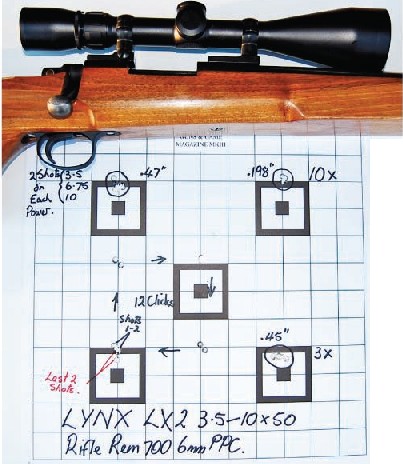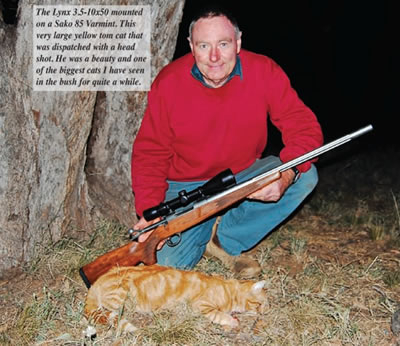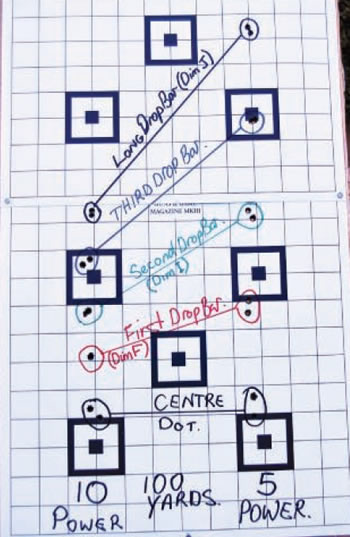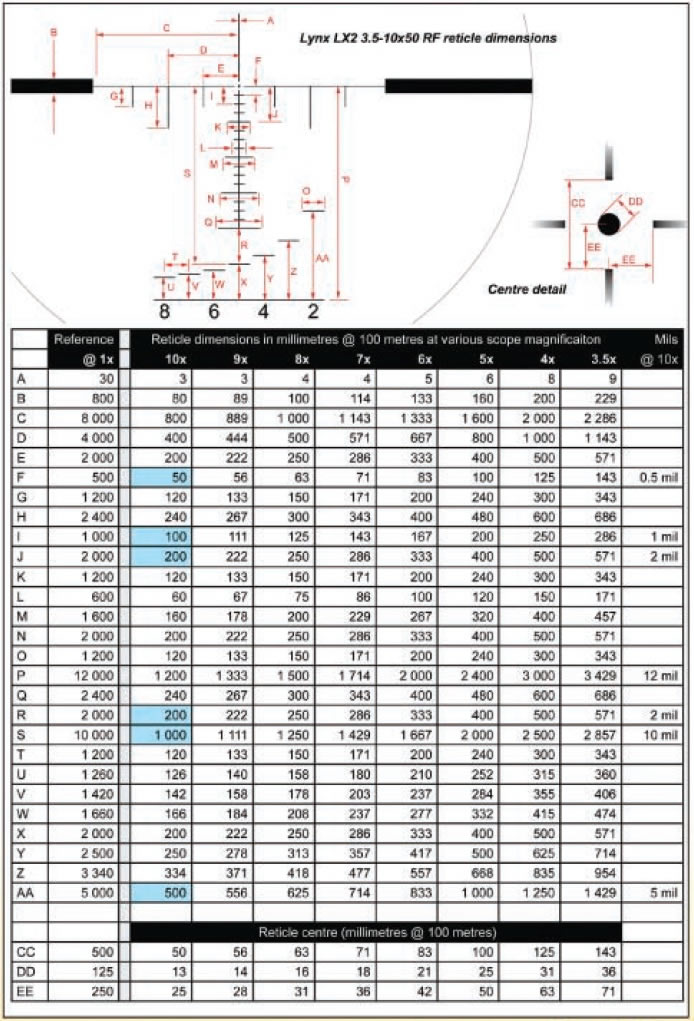
Lynx LX2 3.5-10x50 RF - By Andy Montgomary

Very complicated reticles are something that leave me a little perplexed as they tend to cause confusion. Nightforce was one of the first of the super complex reticle systems I had the pleasure of using. Why did I call it a pleasure, well, I can enjoy a simple reticle more when I go back to it. It was very fine, and at its best in bright daylight as it gave the finest of fine aiming marks. It is quite a while since I used the Nightforce, but I think Lynx may have pipped Nightforce in the complicated reticle department. Glass etching has given scope manufacturers a whole new canvas on which to dazzle us with their intricate reticle designs.
This new reticle from Lynx comes with four A4 pages of instruction on how to use it. The last page is solely to do with the subtentions and dimensions of the reticle. The main table gives this information for each power as well, in millimetres at 100 metres. So, those students in the shooting world, here is your homework - memorise all this information and be able to put it into practice on the next game animal you draw a bead on!
The scope we are looking through is a Lynx Professional Series 3.5-10x50 of one piece mono tube construction with the addition of a glass etched Range Finding reticle. The optics are, what we have come to expect from Lynx with edge to edge clarity and sharp image on all powers being excellent. The ocular focus is lockable and once focused performed perfectly for the whole of the test. It is great to have a current model scope that has a lockable focus.
The reticle has no fewer than 23 aiming points and with some imagination you could stretch that to 50 odd, suffice to say there are way more than I can imagine a use for. After reading through the range finding instructions several times and studying the tables and taking into account that the Lynx engineers have calculuated the animal dimensions for different powers for a given species, total confusion reigns, aside from the fact that we do not have those species here, they don't tell you what to do when you have ranged the target. The more I studied the instruction sheet the more confused I got. If the animal is smaller than one metre from ground to the withers (top of the shoulders) the distance readings must be halved! Then we talk in mils which is not millimetres, but rather the US Military "mils" or Mill radian which is a measure of angle similar to "Minute of Angle", but they are not the same. Which when expressed in inches at 100 yards IMIL is 3.6" approximately and 1 minute is for all intents and purposes 1.04"' at 100 yards. The scope is designed that 1 Mil equals 100 mm at 100 metres.
K.I.S.S is definitely not part of this reticle's specification, however if you stick to ranging with the scope set on 10 power, it would be a useful system with the limitations that you still need to have an idea of the targets dimensions to be able to use the range finding system. It is much simpler to use infrared / laser and a computer chip to calculate the range. As for using the varying widths of the cross bars as a windage hold system you would also need the addition of wind flags and lady luck.
Looking at the dimensions of the very centre of the reticle I can sec some useful measurements to remember. For instance, the distance from the centre of the dot to the start of the cross bars is 25mm at 100 metres.That's 50mm at 200 metres and 75mm at 300 metres, 100mm at 400 metres etc. The other very useful dimension is to the first drop bar under the centre cross (Dimension f) 50mm @ 100 metres. which is 100mm @ 200 metres; 150mm @ 300 metres; 200mm @ 400 metres. That's about all I would try to remember. All these subtentions are on 10 power
 |
(Left)The lockable focus - the way all scopes should be. The power ring with the very tactile flutes and the location bar so you know where you are on the power scale without looking. You may need a little practise for that. (Right) The turrets on the Lynx.The windage turret is pulled out so the scale can be zeroed. Notice the scale under tire adjusting wheel shows how much of the adjustment has been used. These turret are very user friendly and looking at the round the target test extremely precise. |
 |

The Lynx Range finding scope was mounted on a Remington 6mm PPC and sighted in, and the normal G&G test performed. The first 5 shot group at 100 yards on 10 power going into a tidy 0.198". The rifle was allowed to cool and a 5 shot group shot on 3.5 power was not quite up to that standard, but 0.45" is not so bad as the reticle on 3.5 power covers 36mm which is very close to the inside of the square of our bull, and on 3.5 power I couldn't really pick where the dot was in the square and the inside ends of the bars (CC on the diagram) is too far from the bull to be of any help in target acquisition. The power change test is pretty close to perfect and would give me plenty of confidence to change powers and expect to hit my target every shot. The round the target test is about as perfect as I have ever seen as I chose 12 clicks and there they are exactly 3" of adjustment not once but 4 times and the lowest shot which was the last shot I tried was my fault. Looking at the results of the whole test this scope is as close to perfect as I have had the privilege to use.
Because Lynx have designed this scope as a range finding system there needs to be a further demonstration of the effects of range finding with this design and to show what could be the outcome if you get it wrong. Looking at some ballistic tables if we look at a game bullet doing 2800fps be it a 100 grain .243, or 140 grain 6.5, or 180 grain .30 cal ,with the scope set on l0 power and your rifle sighted in to hit the point of aim at 100 yards. lf we look at the reticle dimensions the first drop bar under the centre (dimension F) which is 50mm (a cat's whisker under 2") remembering that each small cross bar is spaced equidistant down the vertical bar so that 2 bars down is 100mm (4"), 3 bars is 150mm (6"), with the first longer bar (cross bar K actually dimension J) is 200mm (8"). If we look back at our ballistic table for a dead on hold at 400 yards the bullet needs to be 195mm (7.7") high at 100 yards if you held the first long bar (dimension l ine J) cross you will hit the target. (Ballistlic table from Hornady Vol 2.) But look across to 5 power which is a reasonable power to have the scope set on for in the bush where a free hand off the shoulder shot may be taken and you get that 400 yard shot and you forget to change the power to 10 and you go for the first long bar as your aiming point your bullet will be approximately 500mm (20") high at 400 yards. Which will be at best a clean miss and at worst a bad wound that will see the animal get away. So you will need plenty or practise at the range to become proficient at checking your range. Look at the target I shot on 10 power and then on 5 power. The loading manual says to be on aim at 400 yards you need to be 7.7" high at 100 yards but we are all but double that at 14" high if we look at the 500 yard line we only need to be 12.2" high at 100 to be on at 500 yards. Conceivably you will be at 18" to 20" (450 to 500mm) hihj at 400 yards on 5 power. If you are holding in the middle of a pig with a 12" (300 mm) deep chest a miss is a guarantee.

Field testing unfortunately only consisted of a couple of hours of hours spot lighting and what rifle to put it on? I had a Sako 85 Varmint in .260 Remington that would be a treat as I could get the scope as low as possible. I also had some 100 gm Nosier Ballistic Tip bullets I wanted to try so this was my chance. After sighting in, the scope was set on 5.5 power in the truck after trying to shoot a bunny at about 40 yards we had furry and fuzzy together and very hard to find (small field of view at 40 yards on 1Ox) Another couple of bunnies were dispatched but none were photo worthy. We were heading down a fence on our way home when there was a set of very bright eyes right at the base of a big box tree about 110 yards. They were too bright for a fox so had to be a cat although there was a fox colour fur through the grass, a very large yellow tom cat was dispatched with a head shot. He was a beauty and one of the biggest cats I have seen in the bush for quite a while.
ln conclusion I can see where the Lynx engineers are going with this system but I personally think in their effort to try and simplify range finding to a given species at a given power they have only complicated the issue. Why, because they have not explained what to do next! As you can see from the example and target given above if you use the power you have ranged the target animal with you now have to go back to the dimension page to work out which drop line to choose and even if you have this page sticky taped to your rifle what happens if that thorny bush you walked too close to 1.5 kms back tore your page half off and it's the half you now need.
Can this scope shoot... Absolutel y ' But it is compiicated
